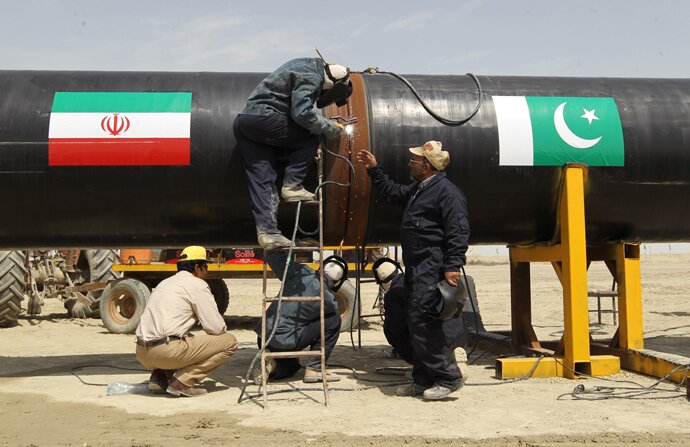
The Iran Sanctions Act passed by the US has a nifty feature called ‘extraterritoriality’ which means that Washington has the power to impose unilateral sanctions on third parties that interact with Tehran. A silent clause however allows dealings as may be determined by them on a case-by-case basis. India has so far managed to escape using this clause with every subsequent review, but they’ve had to diversify their sources and reduce dependence on Iran. Not surprisingly India’s crude imports from Iran have been steadily decreasing with massive fluctuations off late. The other impediment in this trade pact is finding the necessary private intermediaries to facilitate the deals. Since the sanctions were enforced, fewer and fewer institutions have been willing to insure the shipped exports, so much so that Tehran has accepted to insure the vessels themselves.
These ad-hoc measures have increased costs of imports but till India diversifies further, there will have to be continual engagement with Iran, which means they need an alternative viable mode of importing; which brings us to the Iran-Pakistan-India pipeline, a perpetual thorn for the US.
The IPI Pipeline was first conceived back in 1989 as a viable mode of transporting natural gas from Iran, to fulfill increasing requirements of India and Pakistan. Over the years during different periods, both India and Pakistan have dillydallied from firm commitments, sometimes buckling to US pressure which has ceaselessly tried to isolate Iran, and sometimes over mistrust and security issues between India and Pakistan. After 26/11, India was firmly out of the project while Iran completed its phase of the construction in late-2009 reaching the Chabahar Port near the Iran-Pak border.
Since early 2011, India has showed renewed interest in the project and some important agreements have been signed as well – and from recent developments, India may have the incentives to snub ongoing US diplomatic pressure.
US stance on the project: Anything but the IPI Pipeline
Their reasons for opposing the project as mentioned before, is to isolate Iran and curb its growing power in the region. A paper by the Heritage Foundation presents recommendations for thwarting this project, most of which have already been applied.
-
Stepping up U.S. energy diplomacy to discourage pursuit of the pipeline, including bilateral dialogue with India and Pakistan.
The US has relentlessly hounded India’s more susceptible neighbour over the years, overtly threatening them on some occasions. Recently they’ve decided to cut back their yearly economic stipend to the dependent nation. - Supporting the Turkmenistan-Afghanistan-Pakistan-India pipeline as an alternative to the IPI pipeline.
Also known as the TAPI Pipeline, this was the senseless counteroffer made by the US, which although shorter in length, costs more, doesn’t have an expected completion date before 2017, as construction is far behind, and most importantly passes through TWO politically unstable countries. Meetings have been held regarding this project, but it hasn’t been given as much priority as the IPI. -
Pursuing U.S.-India civil nuclear cooperation.
This is a classic example of dangling the carrot before the horse. In early 2004 a UNDP Report by Stanford educated Pakistani petroleum engineer Gulfaraz Ahmed titled ‘Peace and Prosperity Gas Pipelines’ was published, which highlighted the potential benefits of the IPI Project to all parties involved. Subsequently in late 2004, a string of meetings were held between the heads of state of India, China, Russia, Iran and Pakistan, all regarding strategic cooperation in the energy sector, which culminated in India announcing the 25years gas purchase agreement with Iran via the IPI Pipeline. This news reverberated through Capitol Hill and they immediately came out with the Civil Nuclear Deal to dissuade India from the IPI project. To better grasp the impact this announcement had in the West, consider Indian Petroleum Minister Mani Shankar Aiyar’s remark after meeting with a Pakistani delegation regarding the project. He said, “The project, if it materializes, would also foreclose whatever prospects remain of the revival of the trans-Afghan pipeline project, which many still see as a raison d’etre of the US intervention in Afghanistan,”.
As it stands today: Both India and Pakistan are moving ahead with Iran
The project on the Iranian side is nearly complete, with the pipeline reaching the Chabahar Port and responsibility now lies with Pakistan to begin construction. There were some delays on the Pakistani front mostly due to ceaseless pressure from the United States but all that is set to change as another wealthy player has shown interest in the project.
While the US has been watching developments with bated breath, stakes on the pipeline have suddenly quadrupled with Pakistan inviting China to invest and participate in the project. China has shown interest in investing in a pipeline from Pakistan northwards into China’s Xinjiang province running parallel to the Karakorum. That aside, Pakistan has also given them operational control of the strategic deep water port in Gwadar. Moreover they are planning to revive the shelved Coastal Oil Refinery project, which was a part of a $12Bn investment plan by China.
Such large investments are a tacit approval by them and has emboldened Pakistan to fearlessly move ahead with the IPI Pipeline, so much so that Petroleum Minister Shahid Abbasi openly claimed that they are not bothered about sanctions. “There is no fear of any sanctions. We are confident that the project will go through and we are pushing for it. Iran is selling gas to Armenia and Turkey. When these countries can buy gas then so can we.”
India too for its own requirements is increasing engagements with Tehran. Apart from the IPI project, India is also moving forward with investing in Iran’s North-South Transport Corridor, which would link the Persian Gulf to the Caspian Sea, creating a vital like with Russia, and northern Europe. They are also developing the Chabahar Port for transport of goods to Afghanistan.
That these engagements would irk the US was a given, and it seems Iran expected the US to try and thwart the project’s success. Even though progress is being made with Chinese backing, there is every chance that Pakistan may flounder if China backs out. To avoid such a contingency Iran has played a master stroke which may entirely negate its dependency on Pakistan to follow through, and hence break US leverage.
Iran’s lucrative offer to India, which would nullify all security concerns it had regarding the project – involves bypassing Pakistan completely by taking the pipeline underwater from Chabahar directly to India. In exchange they want India to shore up its crude imports, which have been falling steadily over the years and secondly invest in their Farzad-B gas field for which they are prepared to sign a production sharing agreement.
These developments are completely altering the geostrategic map of the region taking the chess game of hydrocarbons to another level. The balance of power is shifting away from the US and they need to make an immediate reassessment if they are to have any control over the region. Iran’s oil buffer has worked well against the sanctions and with this pipeline it should render it completely ineffectual. Dangling the carrot has not worked for the US, and it may have no other option but to threaten to use the stick.
Though Pakistan isn’t new to such a reception, India could well start to receive the first warnings if they continue their association with Iran. Certainly not as an overt threat, but there are many areas where they could tighten controls to let their displeasure be known. They could for instance reduce cut the availability of H1B visas, something India has been pushing for since long; not to mention the possibility of stemming investments or imports from the country, a move which could be devastating given the present situation of the economy.

